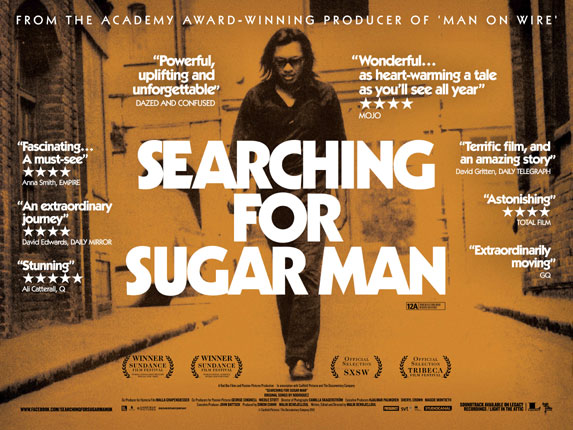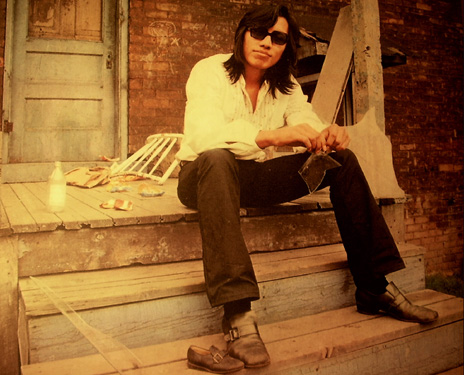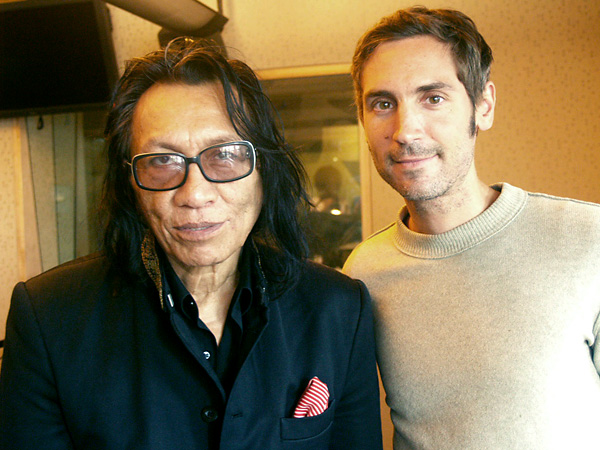As a man on the veritable cusp of being an “old guy,” I appreciate all never-too-late success stories. But the tale of the singer named Rodriguez transcends any such story that I’ve ever heard, and to say that it is heartwarming is to be dealing  in gross understatement. A great many people know the story now, given the 60 Minutes segment that Bob Simon did a while back, or the 2012 film, Searching for Sugar Man—which just happened to win the Academy Award last week for best full-length documentary. But for those who don’t know, here’s the short blog post version.
in gross understatement. A great many people know the story now, given the 60 Minutes segment that Bob Simon did a while back, or the 2012 film, Searching for Sugar Man—which just happened to win the Academy Award last week for best full-length documentary. But for those who don’t know, here’s the short blog post version.
Sixto Rodriguez, born in 1942, lived a life of poverty in his hometown of Detroit. As a musician he wrote and performed his own songs in small venues such as bars and coffeehouses. In the late 1960s his Dylan-esque style caught the attention of a Motown producer. His first album, Cold Fact, was released in 1970 to excellent reviews—and great indifference from record buyers. A second album, Coming From Reality, followed a year later, with a similar response. Little was heard of Rodriguez subsequent to that—in the United States, anyway.
There are a number of more-than-likely apocryphal stories of how pirated tapes of Rodriguez’s albums wound up in South Africa later in the ’70s, but somehow they did. This happened at a time of great unrest in the country, as people began to challenge the hardline apartheid views of their repressive government. His music, especially songs like “The Establishment Blues” and “I Wonder,” resonated with young South Africans, many of whom would come to consider Rodriguez’s music the “soundtrack of their youth.” Reissued LPs soon sold over half a million copies and had the government suppressing some of the lyrics.
Big problem, though: no one knew a thing about Rodriguez—who he was, where to find him. Nor did Rodriguez—or anyone, for that matter—know what was happening in South Africa. Eventually the story surfaced that Rodriguez was

Rodriguez, then…
dead—he’d burned himself to death on stage during a performance. South Africans believed that tale for a long time—and his popularity grew.
It took over two decades for a Cape Town record store owner to connect the word “Dearborn” in one of his lyrics with a town near Detroit, and he traveled to the Motor City to see if he could learn anything more about the “late” Rodriguez. He found the singer quite vertical, living in a ramshackle house that he’d occupied for forty years in a run-down part of the city. For decades he’d supported himself as a day laborer in heavy construction. The news that he’d likely sold more records in South Africa than Elvis or the Beatles stunned Rodriguez.
In 1998, ecstatic over the “resurrection” of their favorite singer, South Africans invited him to perform in their country. On March 6 (my birthday; I love coincidences) the humble, soft-spoken Rodriguez stood before a full auditorium of more than 5,000 screaming fans, whose thunderous applause kept him from starting his show for ten minutes. Need I say the performance was a huge success?
But once back home it was the same for Rodriguez: walking the mean streets of Detroit and working construction jobs, an invisible man in his own country. South Africa had him back a number of times over the ensuing decade, but little happened here, until…
A young Swedish filmmaker named Malik Bendjelloul happened to be looking for a unique story from which he could direct a documentary. He fell in love with the unbelievable tale of Rodriguez’s “resurrection” and spent years working on what would come to be titled, Searching for Sugar Man. (The song, “Sugar Man,” is the lead track on the Cold Fact album.) He

Rodriguez and filmmaker Malik Bendjelloul
eventually ran out of money—on a shoestring budget he’d shot some of the film on an iPhone with an 8mm app—and had to stop production. The unfinished film was submitted to the Sundance Film Festival and became a hit. A major film studio supported its completion, and the film went on to win a number of prestigious awards, culminating with the Academy Award.
Rodriguez, about to resume a worldwide tour later this month in Australia, is in demand, as evidenced by many sold-out concerts. Check out his website, Sugarman.org for a venue near you. My wife and I bought tickets (standing room only!) to see him perform in San Francisco later in April, since no dates close to us in the San Diego area were listed. They have since added an April date in Los Angeles, which is where we’ll be headed. Having viewed the film and listened to the albums a number of times, we can’t wait.
Sixto Rodriguez, now seventy years old, has poor eyesight and walks with some difficulty, the result of decades of backbreaking labor. But success for this “old guy” has finally come, and I’m sure he could not be more gratified.

Inspiring! Hoping to catch the show in April. 🙂
I hope you have tickets–or can get them. They’re hot! And will be well worth it. 🙂
I nominated you for the Beautiful Blogger Award. Feel beautiful! 🙂http://factorymaid.wordpress.com/2013/03/05/beautiful-blogger-award-aka-holy-shit/
Wow, I’m honored! Thanks much!!!
Yes, this is exceptionally inspirational and I’m really glad that it didn’t end with some version of “they finally discovered him and he became famous…after he died”!
It’s a nice thought that so many artists (of whatever variety) have been appreciated throughout the ages…after they left us…but how many of them never knew that appreciation while they were alive? I’m incredibly happy for Rodriguez because it really is far better late than never.
And Happy Birthday!
People who saw the movie without knowing anything actually cheered–my wife included–when the window in the old Detroit house opened and Rodriguez stuck his head out. It’s awesome to still have him around.
And thanks for the birthday wishes!